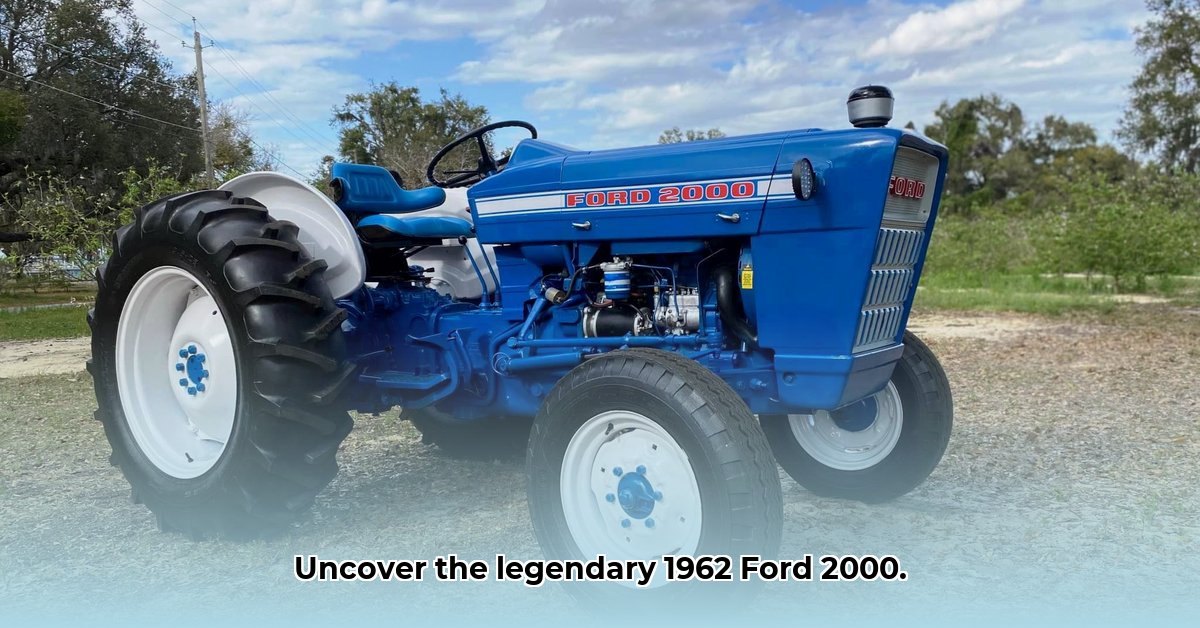
The 1962 Ford 2000 tractor—a stalwart of its era—holds a special place in agricultural history. Produced until 1975, this robust machine offered farmers a reliable and versatile workhorse. This comprehensive guide explores its history, specifications, operation, restoration, and even its place within the competitive landscape of its time. Whether you're a seasoned collector, a prospective owner, or simply intrigued by this iconic machine, this guide provides the essential information you need. For more on Ford tractors from the 1950s, check out this helpful resource.
A Blast from the Past: The Ford 2000's Development
The Ford 2000 wasn't static; it evolved over its production run. Early models (1962-1965) differed slightly from later iterations (1965-1975). These changes, though often subtle, reflect Ford's ongoing commitment to improvement and refinement. Understanding these variations is key to appreciating the tractor’s full history. It's like comparing a vintage muscle car across its production years - the core remains, but small details and engineering improvements enhance the user experience.
Under the Hood: Specifications and Performance
Let's delve into the technical details. Remember that minor variations may exist depending on the specific year and model. Always consult your owner's manual for precise specifications.
| Feature | 1962-1965 Model | 1965-1975 Model | Notes |
|---|---|---|---|
| Engine | 2.2L Gasoline, 2.4L Diesel | 2.2L Gasoline, 2.4L Diesel | Engine type significantly impacted power output and fuel efficiency. |
| Horsepower (approx.) | ~36 hp | ~36 hp | Advertised horsepower; actual drawbar and PTO horsepower were generally lower. |
| Transmission | 4-speed, 5-speed | 4-speed, 5-speed, 10-speed Power Shift | Transmission choice greatly influenced versatility and operational efficiency. |
| PTO Horsepower | Varied | Varied | Power available at the power take-off (PTO) shaft, crucial for implements. |
| Lift Capacity | Varied | Varied | Weight the three-point hitch could lift; varied with configuration. |
| Fuel Tank Capacity | ~13 gallons | ~13 gallons | Relatively small; frequent refueling was necessary for extended operation. |
| Hydraulic Capacity | ~2 gallons | ~2 gallons | Limited capacity; suited to simpler implements. |
| Weight | Varied | Varied | Weight varied considerably depending on added weights and configurations. |
Did you know? The 10-speed Power Shift transmission, introduced later in the production run, was a significant technological advancement for its time, offering greater control and efficiency.
Keeping Your Ford 2000 Running Smoothly: Essential Maintenance
Owning a classic tractor requires a commitment to regular maintenance. Think of it as preventative care – proactive maintenance will extend the life of your investment significantly.
- Oil Changes: Essential. Use the manufacturer-recommended oil type and weight, ensuring optimal engine lubrication and longevity. This is probably the single most effective thing you can do to maintain your tractor.
- Fluid Checks: Monitor transmission fluid, hydraulic fluid, and coolant levels regularly. Top off as needed with the correct fluids.
- Belts and Hoses: Inspect for cracks, wear, and deterioration. Replace immediately when issues arise, preventing potential breakdowns.
- Battery Care: Clean battery terminals and consider using a trickle charger if the tractor is stored for a while.
- Tire Health: Maintain proper inflation and rotate tires periodically for even wear.
Parts Sourcing: Sourcing parts for a vintage tractor can be challenging. Online forums, specialist parts suppliers, and even knowledgeable local mechanics are invaluable resources. Don't underestimate the power of online communities dedicated to vintage Ford tractors!
Restoring a Ford 2000: A Labor of Love
Restoring a Ford 2000 is a rewarding but demanding project. It requires mechanical aptitude, patience, and diligent attention to detail.
- Assessment: Begin with a thorough inspection, documenting all necessary repairs and replacements.
- Disassembly: Methodically disassemble the tractor, photographing each step for later reference.
- Parts Acquisition: This phase often is the most time-consuming. Online auctions, dedicated forums, and specialist suppliers are your allies.
- Repair & Replacement: Repair or replace damaged components using high-quality parts.
- Reassembly: Carefully reassemble the tractor, referring to your photographic documentation.
- Testing & Tuning: Thoroughly test all systems to ensure proper functionality before field operation.
The Ford 2000's Competitive Landscape
The Ford 2000 competed with other notable tractors of its time, such as John Deere and Massey Ferguson models. While it might not have always outmatched competitors in pure horsepower, its reliability, simplicity, and ease of maintenance likely contributed to its popularity.
Safety First: Vintage Tractor Operation
Vintage tractors like the Ford 2000 lack many modern safety features. Always prioritize safety:
- Wear appropriate protective gear.
- Be mindful of the tractor's limitations and operating environment.
- Never work alone.
- Understand the machine's mechanics thoroughly.
- Consider adding modern safety features if possible.
Important Note: The lack of features such as ROPS (Roll Over Protective Structures) makes rollovers a significant risk. Exercise extreme caution.
Legal Compliance: Operating Within the Law
Operating regulations for vintage tractors vary by location. Research and comply with all local and national regulations regarding emissions, safety standards, and operational restrictions before using your Ford 2000.
Conclusion: A Legacy of Hard Work
The 1962 Ford 2000 tractor remains a testament to enduring engineering and its role in shaping agriculture. Whether actively used or lovingly restored, this machine holds a cherished place in the history of farming. This guide provides a foundation for understanding and appreciating this classic workhorse. Further research, utilizing online forums and specialist resources, will deepen your knowledge and appreciation.